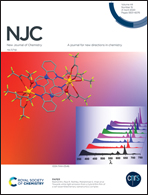Thermally induced spin crossover in Fe(PyrDer)2[Fe(CN)5NO] with PyrDer = 4-substituted pyridine derivatives†
Abstract
The 2D hybrid inorganic–organic solids herein under study were prepared by intercalation of organic molecules between neighboring layers of ferrous nitroprusside. In the formed solid, the organic molecules (4-methylpyridine, 4-acetylpyridine, 4-pyridinecarboxyaldehyde, and 4-vinylpyridine) are found occupying the axial coordination sites of the iron atom linked at the equatorial N ends of the CN ligands in the pseudo-octahedral [Fe(CN)5NO] block. The resulting 3D framework of these hybrid solids is supported by intermolecular dispersive, C–H⋯π and dipole–dipole interactions in the interlayer region, with a contribution from dipolar coupling between unlinked NO and CN ligands from neighboring layers. Such intermolecular interactions modulate the coordination geometry of the iron atom. The local crystal field sensed by the latter is such that on material cooling and then on heating, a spin crossover transition with pronounced thermal hysteresis is observed. Both the transition temperatures and hysteresis are determined by the nature of the intercalated molecule. The mentioned structural features and the thermally induced spin transition were studied using the refined crystal structures, magnetic measurements, Mössbauer, Raman, and IR spectra, and DSC data. These experimental studies were complemented by computational calculations of the iron atom coordination environment. To the best of our knowledge, this is the first study on the preparation and characterization of this series of hybrid 2D solids, and of their thermally induced spin crossover effect.
![Graphical abstract: Thermally induced spin crossover in Fe(PyrDer)2[Fe(CN)5NO] with PyrDer = 4-substituted pyridine derivatives](/en/Image/Get?imageInfo.ImageType=GA&imageInfo.ImageIdentifier.ManuscriptID=D0NJ00595A&imageInfo.ImageIdentifier.Year=2020)


 Please wait while we load your content...
Please wait while we load your content...